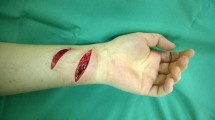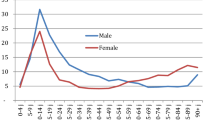Abstract
Despite being a common form of abuse, there is a paucity of literature describing shackling and wrist restraint injuries among survivors of torture. Forensic evaluation of alleged wrist restraint/handcuff injuries in survivors of torture presents challenges to the evaluator, especially if the injuries are remote and do not leave lasting marks nor neurologic deficits. Thorough history-taking and physical examination are critical to effective forensic documentation. Guidance is provided in The Manual on Effective Investigation and Documentation of Torture and Other Cruel, Inhuman or Degrading Treatment or Punishment (Istanbul Protocol), the gold standard for the medicolegal documentation of torture. This guidance relies primarily on physical findings, with less direction provided on how to interpret historical evidence or when historical evidence provided by the patient can be interpreted as highly consistent with alleged injury in the absence of current physical findings. Through a case-based review, we present diagnostic strategies for the evaluation of alleged abuse involving wrist restraints/handcuffs, focusing on skin, neurologic, and osseous injuries. We highlight key findings from both the history and physical examination that will allow the evaluator to improve the accuracy of their expert medical opinion on the degree to which medical findings correlate with the patient’s allegations of wrist restraint injuries.





Similar content being viewed by others
Data availability
Not applicable
Change history
09 June 2021
A Correction to this paper has been published: https://doi.org/10.1007/s00414-021-02584-1
References
UN General Assembly (1984). Convention against torture and other cruel, inhuman or degrading treatment or punishment – Article 1. Accessed from https://www.ohchr.org/en/professionalinterest/pages/cat.aspx. Accessed 3 Dec 2020
Moreno A, Grodin MA (2002) Torture and its neurological sequelae. Spinal Cord 40:213–223
Ghaleb SS, Elshabrawy EM, Elkaradawy MH, Welson NN (2014) Retrospective study of positive physical torture cases in Cairo (2009 & 2010). J For Leg Med 24:37–45. https://doi.org/10.1016/jflm.2014.03.005
Office of the United Nations High Commissioner for Human Rights (2004) Istanbul Protocol – Manual on the Effective Investigation and Documentation of Torture and Other Cruel, Inhuman or Degrading Treatment or Punishment. Accessed from https://www.ohchr.org/Documents/Publications/training8Rev1en.pdf. Accessed 3 Dec 2020
Howard JD (2005) Restraint techniques, injuries and death. Encyclopedia For Leg Med:541–547. https://doi.org/10.1016/B0-12-369399-3/00310-4
Chariot P, Ragot F, Authier FJ, Questel F, Diamant-Berger O (2001) Focal neurological complications of handcuff application. J For Sci 46(5):1124–1125
Grant AC, Cook AA (2000) A prospective study of handcuff neuropathies. Muscle & Nerve 23(6):933–938. https://doi.org/10.1002/(sici)1097-4598(200006)23:6<933::aid-mus14>3.0.co;2-g
Richmond PW, Fligelstone LJ, Lewis E (1988) Injuries caused by handcuffs. 297(6641):111–112. https://doi.org/10.1136/bmj.297.6641.111
Haddad FS, Goddard NJ, Kanvinde RN, Burke F (1999) Complaints of pain after use of handcuffs should not be dismissed. BMJ 318(7175):55. https://doi.org/10.1136/bmj.318.7175.55
Ball L, Ferran NA, Barton CR (2008) Scaphoid fracture due to rigid handcuffs. J Hand Surg Euro 33(4):484–487. https://doi.org/10.1177/1753193408089055
Hilton M, Yngve D, Carmichael KD (2006) Proximal humerus fractures sustained during the use of restraints in adolescents. J Ped Ortho 26(1):50–52
Human Rights Watch (2019) Mali: Detainee Restraints Causing Grievous Injuries. Accessed from https://www.hrw.org/news/2019/10/02/mali-detainee-restraints-causing-grievous-injuries. Accessed 3 Dec 2020
Stone DA, Laureno R (1991) Handcuff neuropathies. Neurology 41:145–147
Kantarci MN, Kandemir E, Berber G, Bastürk M, Korur Fincanci S (2013) Evaluation of plastic and metal handcuff-related injuries under custody in medical examinations. Turkiye Klinikleri J Med Sci 33(2):360–365. https://doi.org/10.5336/medsci.2012-28651
Ehrlich W, Dellon AL, Mackinnon SE (1986) Classical article: cheiralgia paresthetica (entrapment of the radial sensory nerve). A translation in condensed form of Robert Wartenberg’s original article published in 1932. J Hand Surg Am 11(2):196–199. https://doi.org/10.1016/s0363-5023(86)80050-8
Dorfman LJ, Jayaram AR (1978) Handcuff neuropathy. JAMA 239:957
Massey EW, Pleet AB (1978) Handcuffs and cheiralgia paresthetica. Neurology 28:1312–1313
Smith MS (1981) Correspondence: handcuff neuropathy. Ann Emerg Med 10(12):668
Dellon AL, Mackinnon SE (1986) Radial sensory nerve entrapment in the forearm. J Hand Surg Am 11(2):199–205
Anthony JH, Hadeed A, Hoffler CE (2019). Cheiralgia Paresthetica. In: StatPearls [Internet]. StatPearls Publishing, 2020 Jan-, Treasure Island (FL). Available from: https://www.ncbi.nlm.nih.gov/books/NBK545200/. Accessed 3 Dec 2020
Taylor A, Giddins G (2017) Post-traumatic de Quervain’s syndrome: a rare condition, often diagnosed late. J Hand Surg Eur 42(5):524–525. https://doi.org/10.1177/1753193416646722
González-Iglesias J, Huijbregts P, Fernández-de-Las-Peñas C, Cleland JA (2010) Differential diagnosis and physical therapy management of a patient with radial wrist pain of 6 months’ duration: a case. J Orthop Sports Phys Ther 40(6):361–368. https://doi.org/10.2519/jospt.2010.3210
Robinson LR, Henderson M (1994) Handcuff neuropathy involving the dorsal ulnar cutaneous nerve. Muscle Nerve 17(1):113–114
Sheean G, Morris JG (1993) Handcuff neuropathy involving the dorsal ulnar cutaneous nerve. Muscle Nerve 16(3):325
Satkunam L, Zochodne DW (1995) Bilateral ulnar handcuff neuropathies with segmental conduction block. Muscle Nerve 18(9):1021–1023. https://doi.org/10.1002/mus.880180916
Mansuripur PK, Deren ME, Kamal R (2013) Nerve compression syndromes of the upper extremity: diagnosis, treatment, and rehabilitation. R I Med J 96(5):37–39
An WT, Evanoff BA, Boyer MI, Osei DA (2017) The prevalence of cubital tunnel syndrome: a cross-sectional study in a U.S. metropolitan cohort. J Bone Joint Surg Am 99(5):408–416
Funding
Miriam Y. Neufeld is supported, in part, by National Institutes of Health T32 Training Grant (GM86308).
Author information
Authors and Affiliations
Contributions
Study conception: Sondra S. Crosby, Sarah Kimball
Literature review: Miriam Y. Neufeld, Sondra S. Crosby
Data interpretation: Miriam Y. Neufeld, Sarah Kimball, Andrew B. Stein, Sondra S. Crosby
All authors contributed to manuscript drafting and/or critical review.
Corresponding author
Ethics declarations
Conflicts of interest
The authors have no conflicts of interest to disclose
Ethics approval
This study utilized anonymized case studies which, after consultation with the Institutational Review Board (IRB) of Boston University and the privacy office of Boston Medical Center, was deemed not require IRB approval and was deemed to be in accordance with institutional ethical standards.
Consent to participate
Not applicable as cases have been anonymized and no recognizable details have been included
Consent to publish
Not applicable as cases have been anonymized and no recognizable details have been included
Code availability
Not applicable
Additional information
Publisher’s note
Springer Nature remains neutral with regard to jurisdictional claims in published maps and institutional affiliations.
Rights and permissions
About this article
Cite this article
Neufeld, M.Y., Kimball, S., Stein, A.B. et al. Forensic evaluation of alleged wrist restraint/handcuff injuries in survivors of torture utilizing the Istanbul Protocol. Int J Legal Med 135, 583–590 (2021). https://doi.org/10.1007/s00414-020-02451-5
Received:
Accepted:
Published:
Issue Date:
DOI: https://doi.org/10.1007/s00414-020-02451-5




